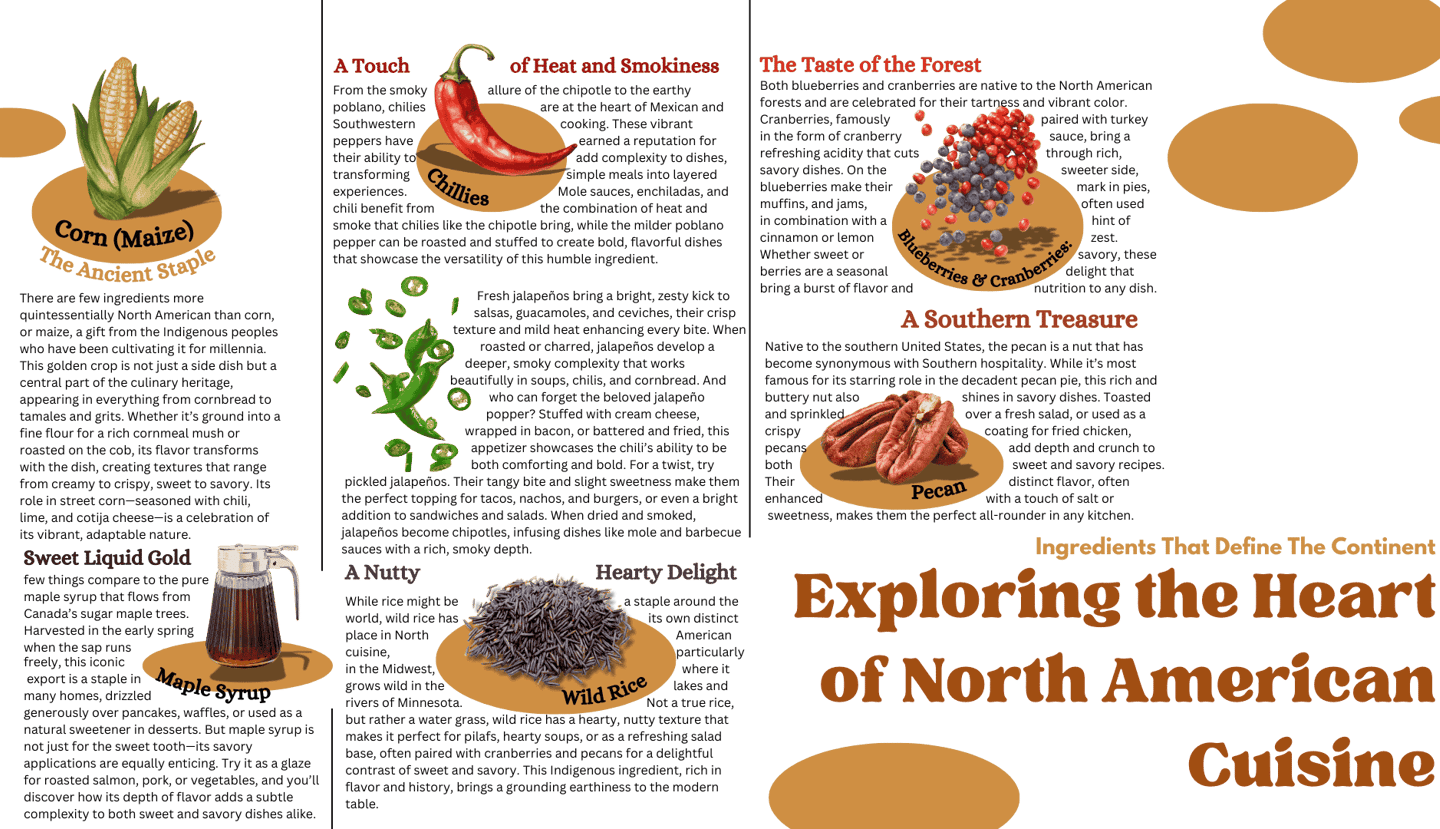North American

North American Cuisine Style:
North American cuisine is a rich mosaic, encompassing the culinary traditions of not only the United States, Canada, and Mexico and also the vibrant flavors of Central America and the Caribbean.
Rooted in centuries of cultural exchange, it draws inspiration from diverse influences, including the innovative techniques of European settlers, the time-honored practices of Indigenous communities, the bold flavors introduced by Asian and Latin American immigrants, and the cherished recipes of Jewish diasporas. This intricate fusion creates a dynamic culinary landscape that is as varied as the continent itself.
Eating in North America feels like endless buffet of flavors, taste, and cultures, genuinely an adventure that never ends of the country of melting pot.
In the land of extremes—one moment, you’re savoring a smoky Barbeque ribs, and the next, you’re crunching into a mexican chipotle or beers all day.
North American cuisine, shaped by its cultural diversity and agricultural innovation, offers a rich tapestry of flavors and health benefits. We have seen more farm-to-table ethos of the U.S., the ancient culinary wisdom of Mexico, or the fresh, sustainable practices of Canada, the continent’s food culture celebrates both taste and nutrition in their way of unique history. By exploring these traditions, we uncover not only each culture's unique dishes but also their potential to inspire healthier eating worldwide.
Do you know the taste tribe of
We could not lie that fusion and modern twist has been everywhere around. Not only around the corner while also in our taste bud. The Taste Tribes of North America's culinary traditions encompass from
Indigenous Cuisines: Traditional foods of Native American communities, such as corn, beans, and squash, often referred to as the "three sisters," play a foundational role in the continent's food history.
European Influences: The cuisines of countries like France, Spain, and the United Kingdom have significantly shaped North American cooking styles, introducing techniques and ingredients that have been adapted over time.
African Contributions: Particularly in regions like the Southern United States, African culinary traditions have melded with local ingredients to create distinctive dishes, such as those found in Creole and Lowcountry cuisines.
Asian and Latin American Flavors: Immigration from Asia and Latin America has introduced a variety of spices, cooking methods, and dishes, enriching the North American culinary scene with sushi, tacos, stir-fries, and more.
North America?
Discuss common dietary patterns across the continent, such as plant-based eating in the Mediterranean or protein-rich dishes in certain African countries.


Focus on Plant-Based Nutrition:
Many dishes from these regions rely on plants, legumes, and whole grains, aligning with modern trends like vegetarian, vegan, and flexitarian populations.
Whether it's the use of black beans in Mexican dishes or the incorporation of wild rice and salmon in Canada, these meals offer a nutrient-rich foundation for balanced eating.
Cultural Integration of Superfoods:
The regions of North America have long embraced superfoods like avocado, chia seeds, quinoa, and omega-3-rich fish. These ingredients have stood the test of time for their health benefits and now play a central role in global wellness trends.
Each region’s cuisine highlights the importance of a balanced diet (carbs, proteins, fats).
The combination of macronutrient in dishes like pupusas, grilled fish tacos, and jerk chicken offers a well-rounded approach to nourishment yet delicious. These dishes inspire meal planning that satisfies nutritional needs while promoting overall health.
Inspiration for Balanced Diets:
(extra sauce: something you might not realized but equivalently important!)
The Cooking Techniques:
Many traditional cooking methods, such as steaming, grilling, and slow-cooking, are incorporated into modern recipes to preserve nutrients and reduce the use of unhealthy fats. These techniques make it easier than ever to prepare meals that are both flavorful and nutritious.




A story from a American cookbook:
This is the story of the "author" says about american kitchen.
A series of cookbook
Origini & History
Origins & History of North American Cuisine
North American cuisine is a rich mosaic shaped by centuries of cultural exchange, innovation, and geographical diversity. Its culinary identity has deep roots in indigenous traditions, influenced over time by waves of immigration and global trade.
Before European colonization, Native American tribes cultivated and prepared foods that remain central to the continent's cuisine today.
Staples such as corn (maize), beans, squash (the "Three Sisters"), and wild game were integral to their diets
Techniques like drying, smoking, and stone-grinding were used to preserve and prepare food. Dishes like cornbread, succotash, and stews have Indigenous origins and continue to influence modern recipes.
Indigenous Foundations
The arrival of European settlers brought a blend of culinary traditions from England, France, Spain, and the Netherlands:
English Colonies: Introduced pies, puddings, and roasted meats, laying the foundation for classic comfort foods.
French Settlers: In regions like Louisiana, they developed Creole and Cajun cuisines, combining French techniques with African, Spanish, and Native American ingredients.
Spanish Influence: Particularly in the Southwest, Spanish settlers introduced techniques like grilling (asado) and ingredients like chilies, cilantro, and citrus, which are now staples in Tex-Mex cuisine.
African Contributions
The transatlantic history trade brought not only forced labor but also the culinary knowledge and ingredients of African peoples. Dishes like gumbo, jambalaya, and barbecue trace their roots to African cooking traditions, with spices, okra, and rice playing a central role which had bring today’s North America a new world of spark.
Immigration Waves
The 19th and 20th centuries saw large-scale immigration that reshaped North American culinary landscapes:
Italian Immigrants: Popularized pasta dishes, pizza, and espresso culture, leading to Italian-American classics like spaghetti and meatballs.
Jewish Immigrants: Brought deli culture, bagels, and smoked fish, particularly to urban hubs like New York.
Chinese and Japanese Immigrants: Introduced stir-fries, soy-based sauces, sushi, and the iconic fortune cookie (an American creation based on Japanese traditions).
Mexican Influence: Mexican immigrants played a key role in popularizing tacos, tamales, and mole sauces across the United States and Canada.
Today, North American cuisine reflects a globalized world. Farm-to-table movements, plant-based dining, and fusion trends are redefining traditional recipes. From food trucks serving Korean tacos to fine dining establishments crafting modern takes on Indigenous dishes, the continent’s food continues to evolve while honoring its roots.










Colonial
Influences





Each dish tells a tale of history, tradition, and the diverse people who shaped the continent's foodscape. Whether it's the soulful comfort of Southern fried chicken or the festive spread of a Thanksgiving table, the food we eat connects us to our roots, communities, and shared experiences.
There is an evolving landscape where tradition meets modernity, and where the past and future collide in the most delicious and nutritious ways.


Chef & Home Cook Features: Stories from the Heart of North American Kitchens
North American cuisine isn’t just shaped by chefs in fancy restaurants; it's made by everyday home cooks, farmers, and food lovers.
Overview: Indigenous peoples used smoking as a method of preservation, a technique embraced in Southern barbecue.
Why North American Cuisine Matters:
Food is a reflection of who we are and where we come from. From the soul-soothing comfort of classic American dishes to the innovative twists chefs and home cooks are adding today, North American cuisine tells the story of the people who shaped it. It’s not just about the ingredients or the technique—it’s about the emotions that come with every bite. Whether you're sharing a meal with family or discovering a new recipe on a busy weeknight, North American food is about connecting to something deeper and more meaningful.
How Regulations Shape the Plate
Behind North America’s nutritional success lies strong regulation. Agencies like the USDA and Health Canada play a pivotal role:
Dietary Guidelines: MyPlate ensures balanced meal planning.
Food Labeling: Nutritional facts help you make informed decisions.
Safety Standards: High-quality, nutrient-retaining processes guarantee freshness.

